Spring-Chi
Kimchi infused with the ephemeral essence of the awakening forest and field. This is the 28th post in the Stacking Functions in the Garden, Food Forest and Medicine Cabinet Series.
This post serves as the 28th post which is part of the above mentioned (Stacking Functions in the Garden, Food Forest and Medicine Cabinet : The Regenerative Way From Seed To Apothecary series)
Years ago, I got tired of all the deflation, and inflation and shrinkflation making my fiat worth very little, my grocery bills skyrocket and the amount of spinach in each supermarket bag steadily decrease (while the price goes up) so I decided to invest in nature’s Gift Economy and do most of my “shopping” in the forest and garden instead.
What I found is that when I combined some basic botanical literacy, pattern recognition, seed saving, composting, patience and foraging by the Honorable Harvest code, I found that I now have access to a nutrient dense shopping list when ever I need it.
Also, unlike the corporate supermarket, the quantity (and quality) available to me in exchange for the time and energy I gift my garden (and/or the forest garden) actually increases with each passing year (not decreases) we can call this “grow-flation” if you like.
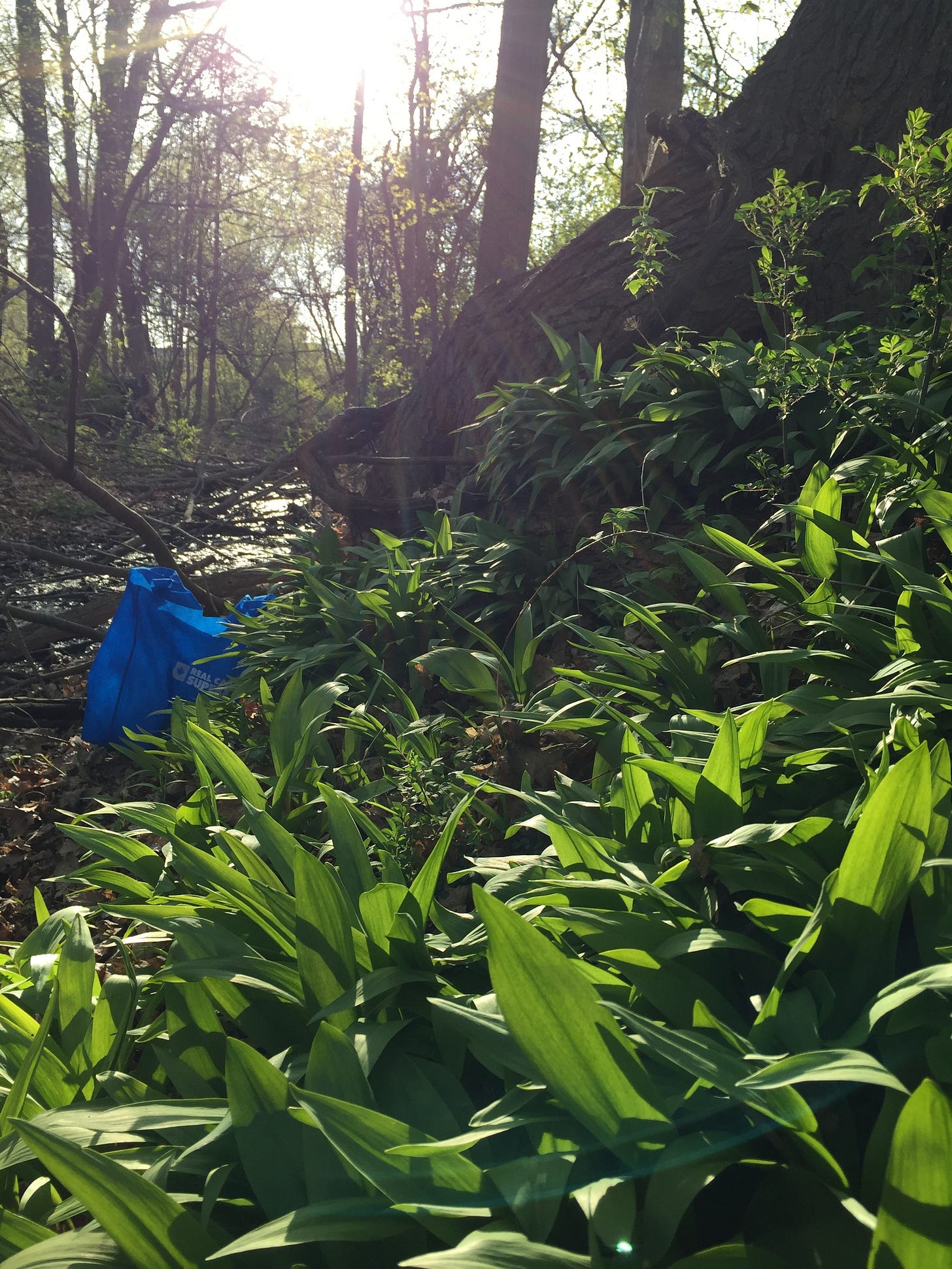
What I have found is that unlike the corrupt government and their corporate partners, the forest does not charge me tax, and my investment of the currency of the Earth’s economy in seeds, wild tending edible forest plants (guerilla gardening) and helping them spread year after year means I increase biodiversity and food available to non-humans and myself year after year.

Such are the blessings available to us when we invest our time and energy in the gift economy of nature and open our lenses of perception to see (and propagate those gifts) within self-perpetuating and regenerative communities of life.
As I was walking in the woods and adjacent fields where I live and feeling gratitude for the spring time abundance (some of which I had helped to sow via guerilla forest gardening in past years and some that was gifted by nature) I felt inspired to create a way to include all the seasonal harvests I was nibbling on and harvesting for soups/tea into a lacto-fermented preserve that would keep their nutritional essence intact while also adding probiotic goodness and fun flavors to the mix. I had been growing some peppers with grow lights in my basement over the winter and had bought a cabbage and some turnips from a local farmers market recently… the thought of a “Spring-Chi” immediately came to mind.
In my post on 30 Reasons To Make Your Own Sauerkraut and Include a Daily Forkful In Your Diet I explored a long list of health benefits that are unlocked by the simple act of teaming up with beneficial bacteria to turn cabbage into sauerkraut. Well, all of the health benefits I outlined in that article are also true of Kimchi except kimchi also offers the additional health benefits of Hot peppers and Ginger (and even more in this case as I include nettles and dandelions)!
Kimchi is a fermented food that’s a staple in Korean cuisine. In fact, it is one of the corner stones of Korean Culture. In the old days it was not only a cherished tradition but also represented a necessity for it meant being able to preserve nutrient dense summer crops through the winter. In the case of this recipe we will be using it to preserve the abundance of spring to enjoy through the summer and fall (technically it could be stored right through to winter, thought I doubt I can stop my self from eating it all before then!). For those unfamiliar with Kimchi, it’s a tangy dish that’s known for its unique flavor. And it’s got plenty of other perks, too.
contains lots of important nutrients
helps maintain a happy, healthy gut
supports your immune system
promotes heart health
protects against oxidative stress
includes beneficial plant compounds
reduces inflammation
boosts brain health
It offers a range of other health benefits as well
This kimchi recipe I am sharing today includes ingredients such as Nettle, Ramps, Spruce Tips, Wild Ginger, farmers market cabbage/turnip, indoor grown chilis, Atlantic Dulse, young Egyptian walking onions, Rhodiola Rosea root, goji shoots / leaves and Dandelion flowers (and more).
This nutrient dense fermented preserve is packed with medicinal compounds and offers Osteoprotective/Osteoregenerative, Radioprotective (artificial EMF protection), Ocular-Regenerative and Ocular-Protective, Neuroprotective health benefits while also optimizing the innate immune system, Cardio-Protective, Cardio-Regenerative Enhancing Reproductive Health, helps with allergies, and helping Detox Glyphosate from your body.
It also offers the body benefits that improve metabolic efficiency, increase circulation, improve energy levels, manage menstruation, digestive stimulant, prebiotic, probiotic, anti-inflammatory, antiangiogenic, antineoplastic, demulcent, minimize menopausal symptoms, aids in skin care, protects the health of the kidney and gallbladder, increase muscle mass, regulate hormonal activity, lower blood pressure, soothe hemorrhoids and improve respiratory conditions.
Beyond providing nourishment and medicine for the body, making preserves that are defined by seasonal abundances such as this also offers spiritual medicine for the heart, mind and soul.
In a time of corporations, governments and techno-optimist/oligarchs trying to sell you technological quick fixes and instant gratification, creating recipe like this invites us to slow down and be present to observe the real world in a time when the purveyors of digital addictions would rather have us endlessly scrolling on smart devices hyper-stimulated (yet perpetually spiritually impoverished) always gorging ourselves (yet never nourished nor satiated) by the mental junk food of artificiality.
If one is looking to create a preserve with ephemeral spring forest, field and garden plants, this requires patience, paying close attention to the stages of awakening taking place as the snow melts and feeling excitement and gratitude when those flavorful, nutritious, visually beautiful (and impermanent) plants finally emerge, providing us ingredients that inspire the senses and align our heartbeat with the heart beat of the living Earth.
“Attention is the doorway to gratitude, the doorway to wonder, the doorway to reciprocity.
Paying attention is a form of reciprocity with the living world, receiving the gifts with open eyes and open heart.”
― Robin Wall Kimmerer, Braiding Sweetgrass: Indigenous Wisdom, Scientific Knowledge, and the Teachings of Plants
Seeking out and foraging for unique ingredients like ramps necessitates (and builds) ecological/botanical literacy and invites us to take an honest assessment of the state of the forest ecosystems where we live.
Ramps, also known as wild leeks (as well as Canada wild ginger/Asarum canadense), are considered excellent indicators of a healthy forest. They thrive in rich, moist soils within deciduous forests and are often found alongside diverse spring wildflower displays. Their presence suggests many decades of a forest ecosystem being undisturbed and able to build rich humus soil via dozens of seasons of leaves being allowed to decompose in place. Through giving our attention to these required conditions for the ingredients for a recipe like this to be available in the first place where we live, we are invited to walk in and tend to the Original Living Cathedrals that were put here by the Creator, and we are invited to participate in a circle of reciprocity, seeding our minds with Gift Thinking and nurturing spiritual wealth to set down roots and grow in our hearts.
Thus, creating recipes like this invites us to remember what our ancestors were wise enough to understand (regarding the imperative of forging a close knit relationship with the land we live on) inviting us to perceive the health of the forest as intrinsically connected to the health and resilience of the community which resides beside or within it. As we forage and wild tend these plants we are immersed in an awareness of the interdependence, sacred geometry, efficiency, resilience and regenerative capacity of the intact ecosystems where we live (which can provide us guidance on the path forward).
Requiring ramps for a recipe in a place like where I live (where 99.98% of all the old growth deciduous forests were clearcut due to ignorance, arrogance and greed) invites one to learn to identify the small fragments of intact forest ecosystem that remain, and then practice The Way Of The Honorable Harvest. This inspired me and invites me to give my time and energy to not only to identify and harvest ramps for myself, but to also think of future generations of ramp foragers as well.
This is certainly a preserve that stacks a great many functions in the garden, food forest and medicine cabinet.
I decided to set up a table outside on my lower deck and make this Chi in the garden whilst appreciating the Magnolia and apple trees in bloom. This allowed me to breath in the ephemeral spring beauty through my eyes and nose while preserving some of it with my hands.
This recipe is an upgraded version of the Garden Chi recipe from my first book with some seasonal additions of spring greens, blossoms and medicine herbs.
Ingredients:
- 1 medium head of green cabbage (or napa cabbage) preferably organically grown
- 1 large softball sized (or two smaller) turnip(s) or one large daikon radish (grated)
- 2 cups packed full of chopped Stinging Nettles
- 2-3 cups packed full of chopped Ramp leaves
- 2 - 3 cups of fresh (fully open) dandelion blossoms
- a handful or two of spruce tips or pine tips (tip for visual presentation, if you want to be able to have discernable spruce tips in the jar and/or finished chi, do not add the spruce/pine tips in with the cabbage while bruising like I did, as they will turn into mush, but rather add them just before putting all ingredients into the jars).
- 10-12 second year freshly emerged Egyptian walking onions greens and bulbs or 12 to 16 fresh green onions, or 3-4 leeks (chopped)
- 1/2 cup diced Goji berry vine new growth shoots/leaves
- 2 pieces of ginger the size of your thumb, grated (or about 2 pieces an inch thick and two inches long)
- 3 to 4 tablespoons ground dried mild-medium heat garden chili peppers (I used a combination of freeze dried ripe Buena Mulata, Biquinho and Cayenne peppers for this batch) some store bought organic sweet paprika will do just fine as an alternative
- (optional for more heat and color) 2 to 3 tablespoons hot pepper flakes (such as gochugaru flakes) or dried heirloom peppers of medium heat
- ½ cup – one full cup of diced hot peppers.
- 3 to 4 teaspoons of unrefined sea salt (only 4 tsp. if temperature of fermentation environment exceeds 27C / 80 F)
- 1 - 2 teaspoons of ground Rhodiola Rosea root
- 2-3 tablespoons diced Wild Canadian Ginger Rhizome
- a handful of dried Atlantic Dulse (seaweed) ripped into small pieces or some kombu, or other seaweed/kelp flakes
- distilled or filtered spring water for making the brine
Optional fun ideas for other ingredients:
- Asparagus
- grape leaves
- red or white clover blossoms
Directions:
Begin by cleaning your fermentation vessels with hot soapy water and rinsing well (I sometimes use one liter wide mouth mason jars for smaller batches, but if you have 2 liter jars or other vessels such as a ceramic crock that will work great too).
Remove the first couple outside leaves of the cabbages if damaged or wilted and discard (compost). Next take a couple fully intact whole leaves, snap them off from the head and set aside for using as a ‘fermentation weight cap’ later.
Then slice the cabbage in half, then in half again so that you may easily remove the core (either setting aside for use as a fermentation weight, to put through a juicer to enrich/add to brine volume or discard into compost as a last resort). The cabbage quarters are then cut into thin strips using a sharp knife or mandolin.
Shred half of the turnip with a grater but cut the other half into bite sized match stick shapes.
Add the cabbage and all the other ingredients to a large mixing bowl and mix well with hands.
While mixing massage the ingredients vigorously as to bruise up the cabbage, pull the juices out and open up the cell walls to help the good bacteria (lactobacilli) to be able to do their work.
Either massage for at least ten minutes by hand in this fashion until the cabbage turns translucent and a brine (vegetable juice) appears in the bottom of the mixing bowl or alternatively use a mallet, rolling pin, pestle or other blunt kitchen instrument to pound the mix of veggies until you achieve the same result. Add the ingredients into bowls (or one huge wooden vessel) in even proportions.
Once bruised and translucent add your Kimchi mixture to your jars (or other fermentation vessel) and pack it in tightly with either your hands to exclude all oxygen until you are about 2 inches from the top of the jar. Cut, fold or tear the whole cabbage leaves you had set aside so that you can stuff them into the jars so that they are snug and will hold all the contents below serving as a “cap”.
Add a fermentation weight, like these (in a pinch you can use either shot glasses or sterilized quartz stones, but something as simple as a left over cabbage core will do)
By this time a brine (salted vegetable juice) should have appeared, If there is not enough brine present to completely submerge the ingredients then create a salt water brine by dissolving 1 ½ teaspoons of salt to one cup (250ml) of water via stirring vigorously, before adding to your jars of kimchi until the ingredients and fermentation weight are completely submerged in brine. Seal the jars and place in a space out of direct sunlight which has an ambient temperature of 16-27C.
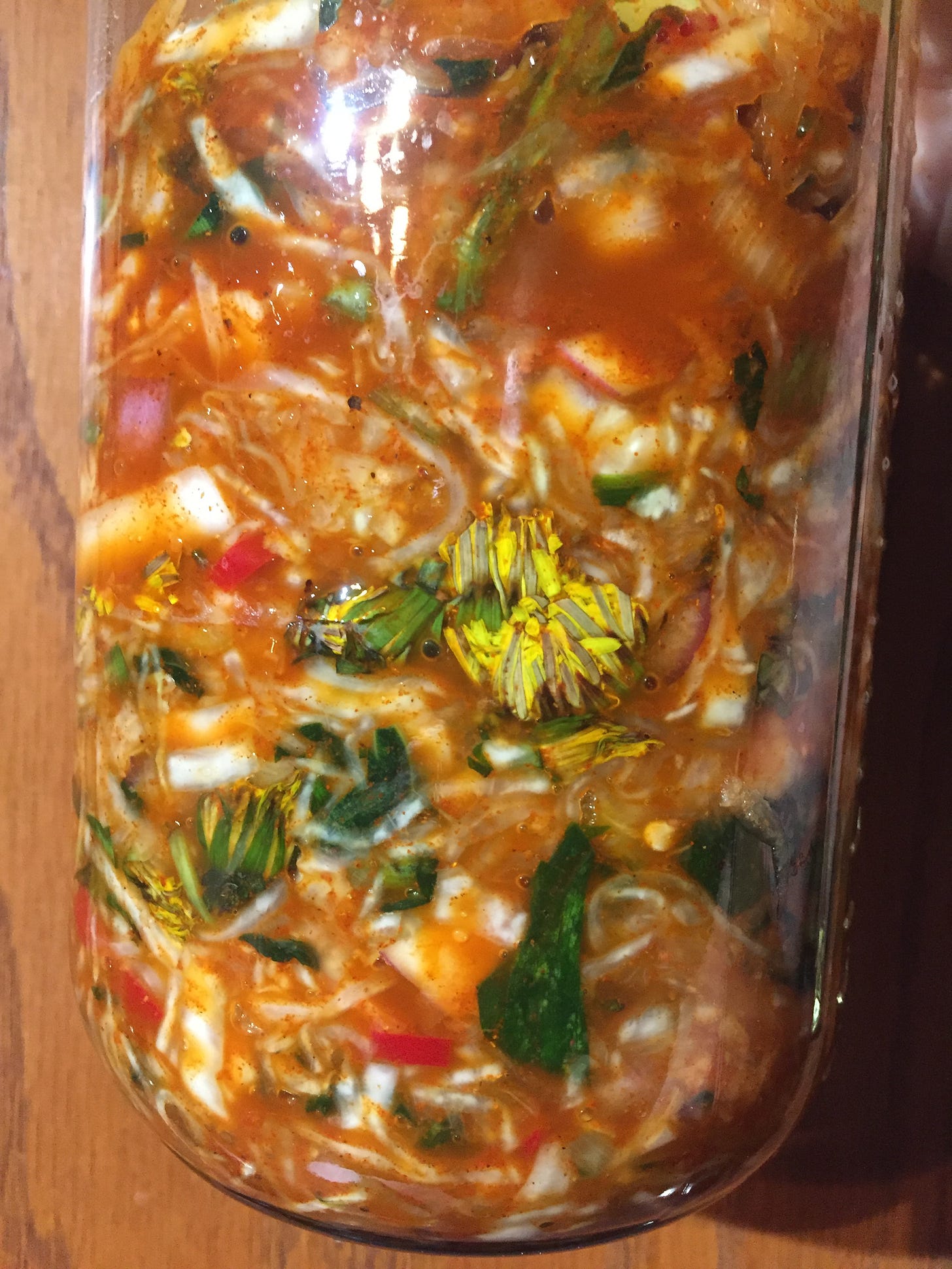
I typically let the Kimchi ferment for at least 7 days before tasting for desired level of tanginess (“burping” daily to release the pent up CO-2 produced by the fermentation process by quickly loosening the ring of your jars to release pressure then tightening back up again. This batch of Spring-Chi was very active and fermented faster (likely had an excellent range of LAB species due to the wild ingredients) so I decided to sperate into small jars and refrigerate after 6 days fermenting.
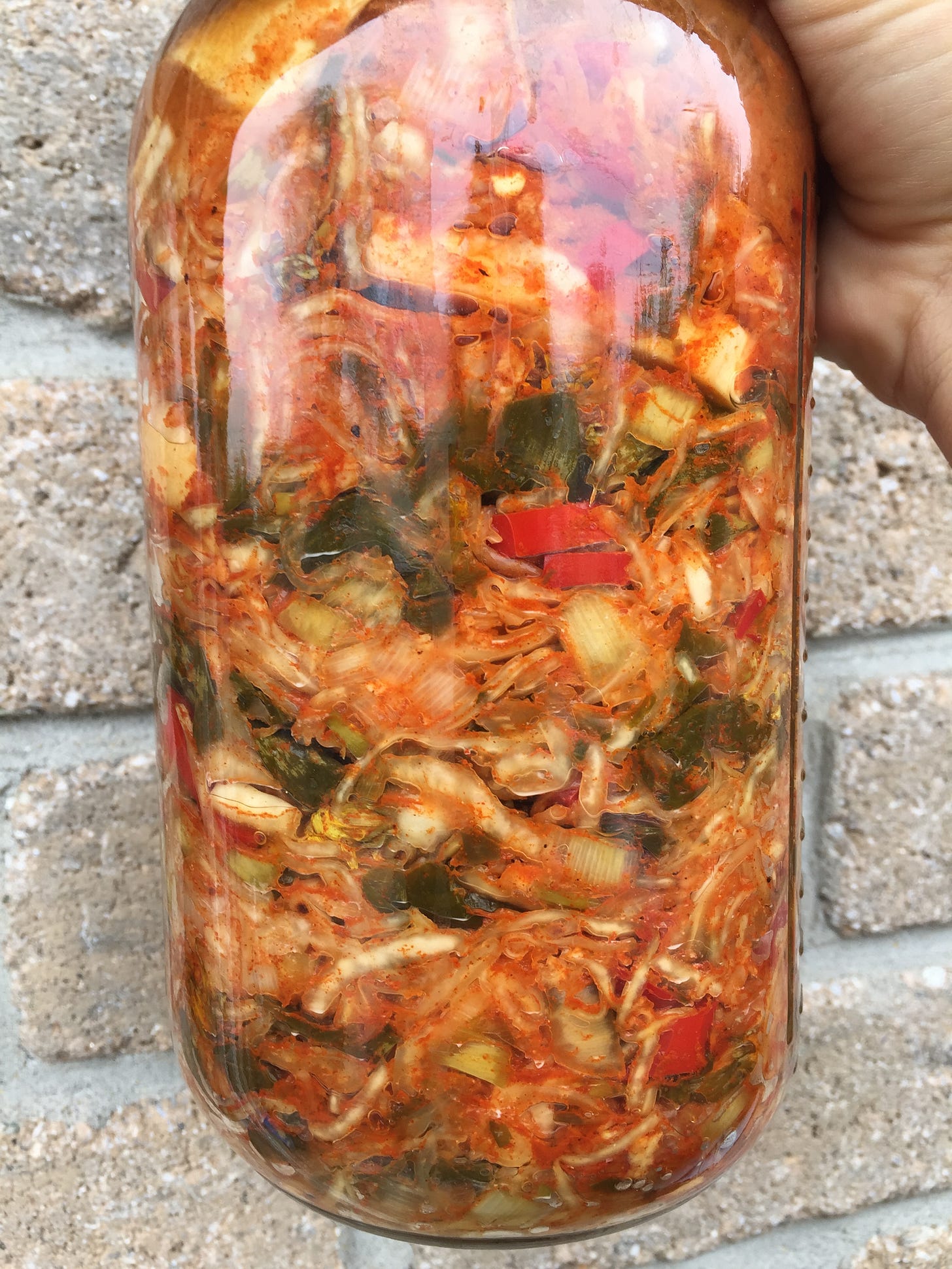
Ferment for 6-14 days, when you have achieved the desired flavor place the jars in a cellar (at 60-70 Fahrenheit) for mid term storage (3-6 months) or place in the refrigerator for long term storage (6-12 months). When removing kimchi from the jars be sure that the brine level is above the loose kimchi before you place back into cold storage adding brine as needed.
I prefer to go the route of "wild" (spontaneous) fermentation (vs culturing/”back slopping”) as this encourages a more diverse range of probiotic species to set up shop in my end product. It is also worth keeping in mind (in both the context of "back slopping" aka culturing, and in the context of when you choose to begin eating or storing your ferment in the fridge) that as the fermentation process proceeds different species will exist in higher concentrations depending on the acidity of the fermented veggie material and brine.
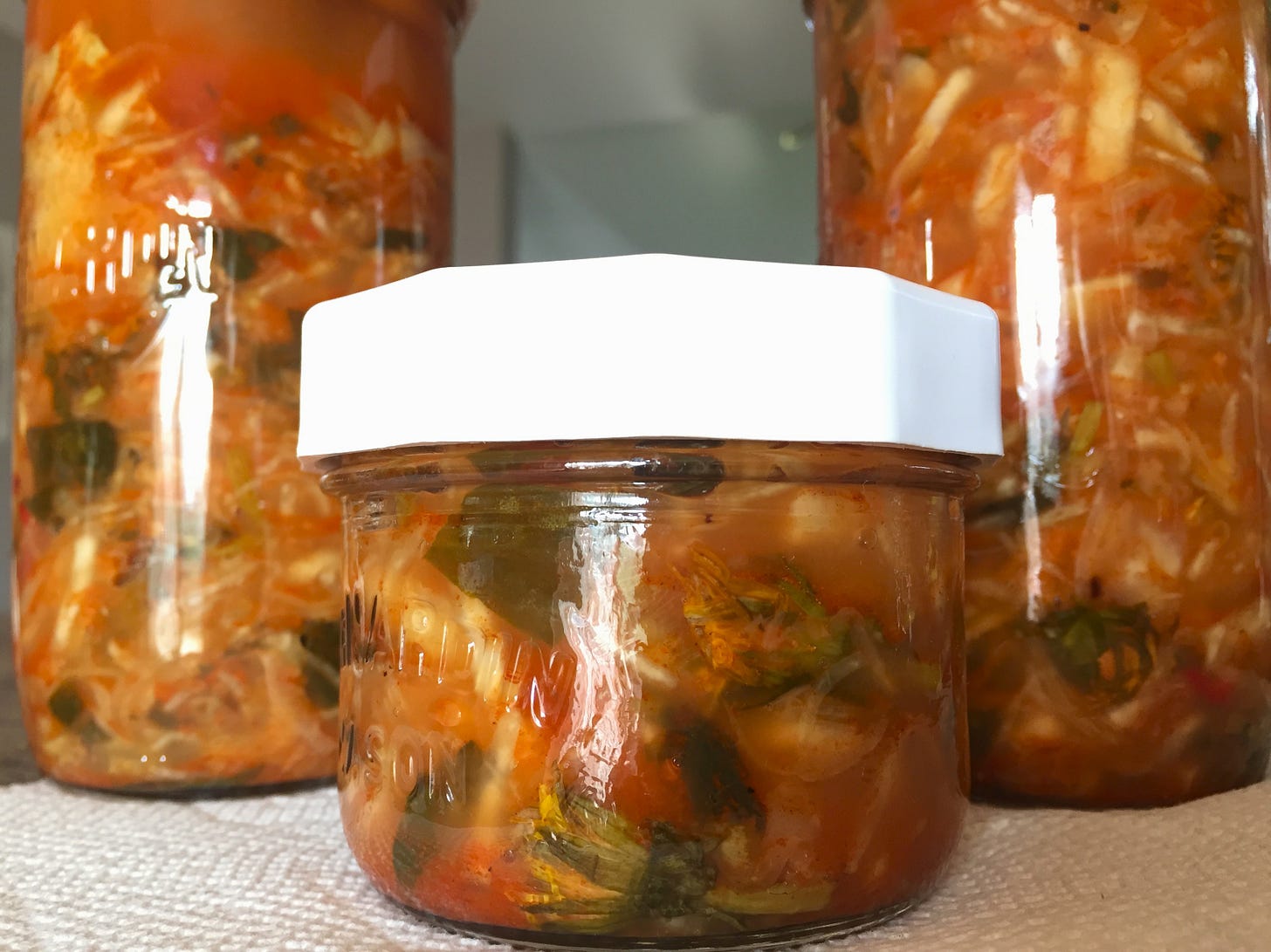
In other words, the longer it ferments, the more acidic (tangy) the sauerkraut will get (which I love the taste of my self) but this also means a more narrow range of LAB species will be capable of surviving in that increasingly acidic environment the longer it sits at room temp.
Thus, whether it is for optimizing culturing or eating to maximize the diversity of probiotic species being ingested, I personally like to eat some of my kimchi and sauerkraut at different stages during the fermentation as to maximize the spectrum of probiotic species I am ingesting (and enjoying different textures and flavors that are available at different stages of the fermentation as well).
Sometimes a young crisp and effervescent kimchi (only fermented for a couple days at room temp) is a refreshing change from the more mature/tangy kimchi that I typically make, so we will switch up how long we wait before putting jars in the fridge when making larger batches so we have variation in textures and flavors for complimenting specific recipes accordingly (labelling the jar appropriately).
I hope you will try making your own version of this at home and tell me how it goes! I absolutely love how mine turned out and I am gonna go back out foraging again this week so I can make a bigger batch (as I know I will eat this one in a matter of weeks and wish I had more).
The recipe above was a sneak peak preview of the kinds of recipes I will be including in my next book (Stacking Functions in the Garden, Food Forest and Medicine Cabinet : The Regenerative Way From Seed To Apothecary).
The recipe for Spring-Chi above is an upgraded version of a recipe from my first book (cover shown in image below).
If you would like to have access to well over a hundred other fun and nutritious recipes like this (including several other fermented preserves) there is info to where you can purchase either a physical or digital copy of my first book below.

For those interested in purchasing a physical copy of my first book you can do so through this link:
https://recipesforreciprocity.com/shop/softcover/






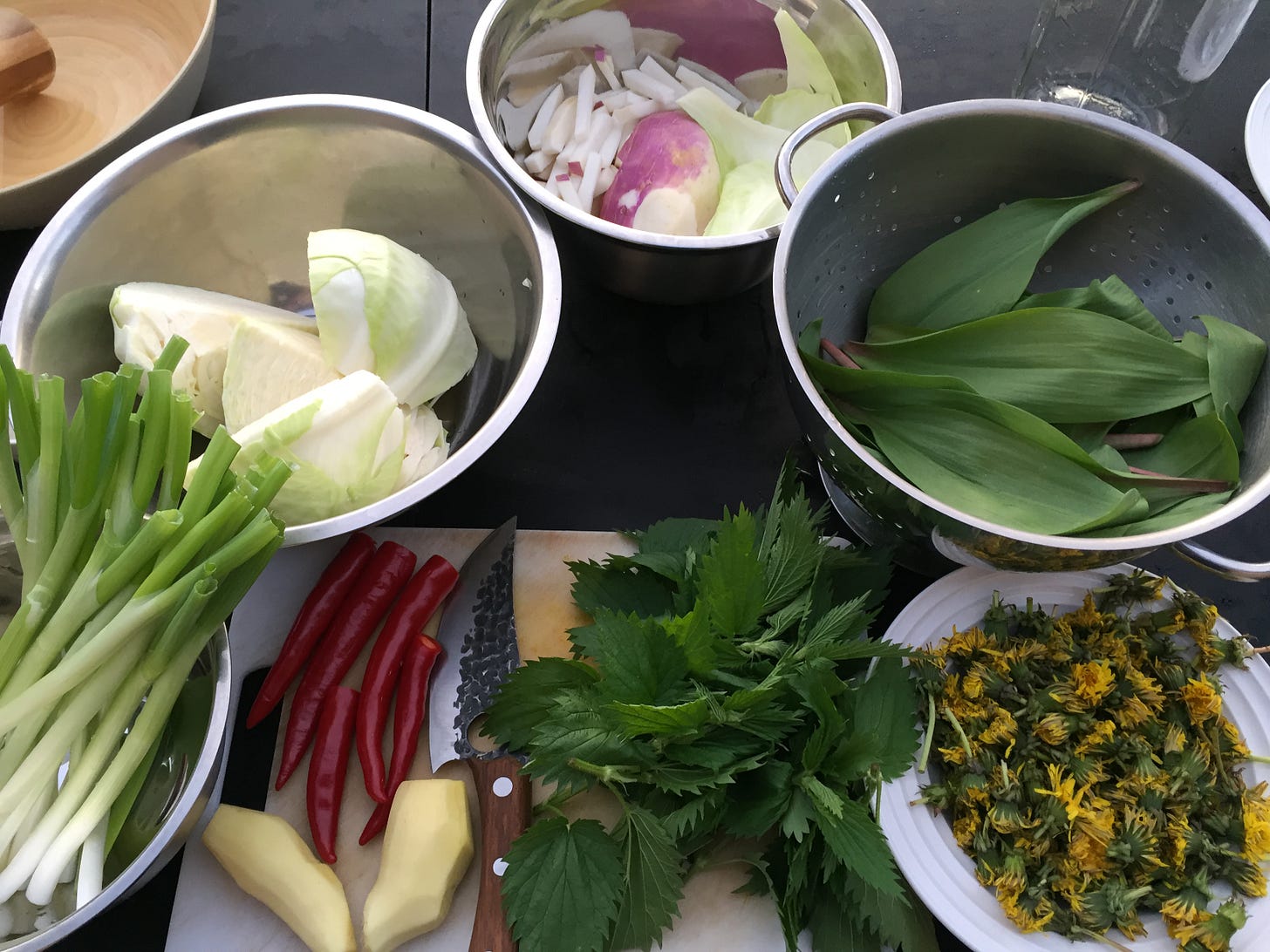
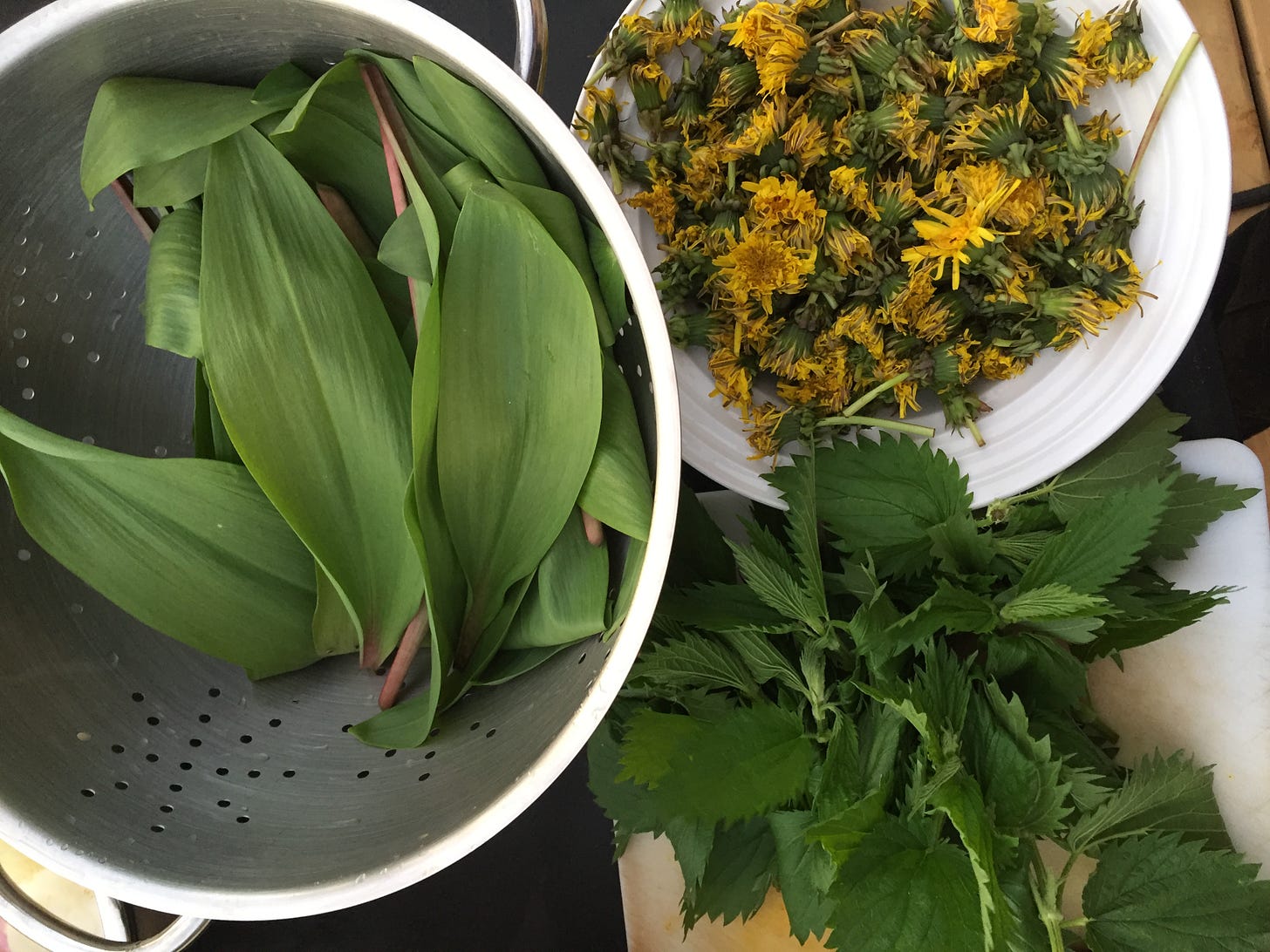

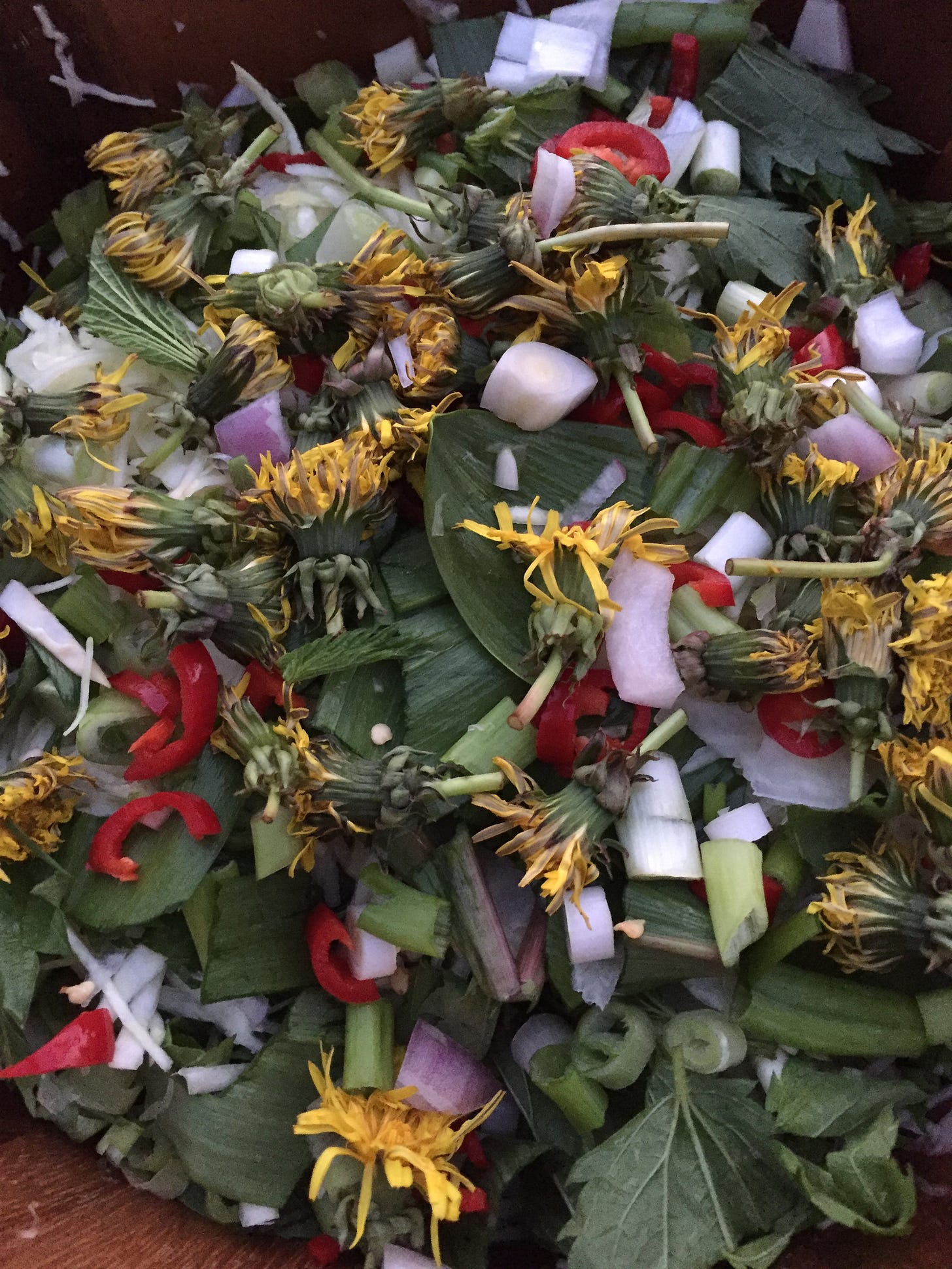
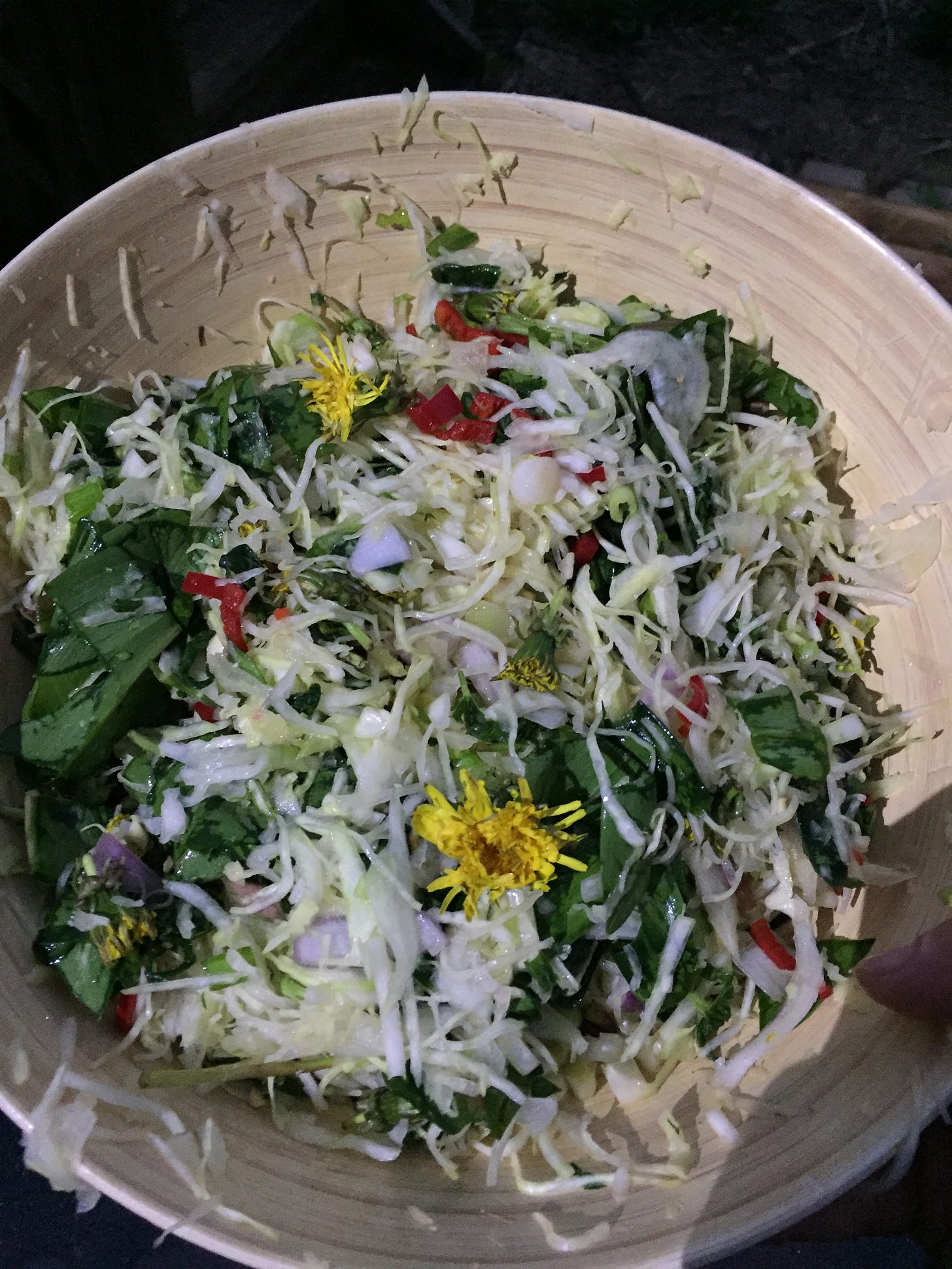
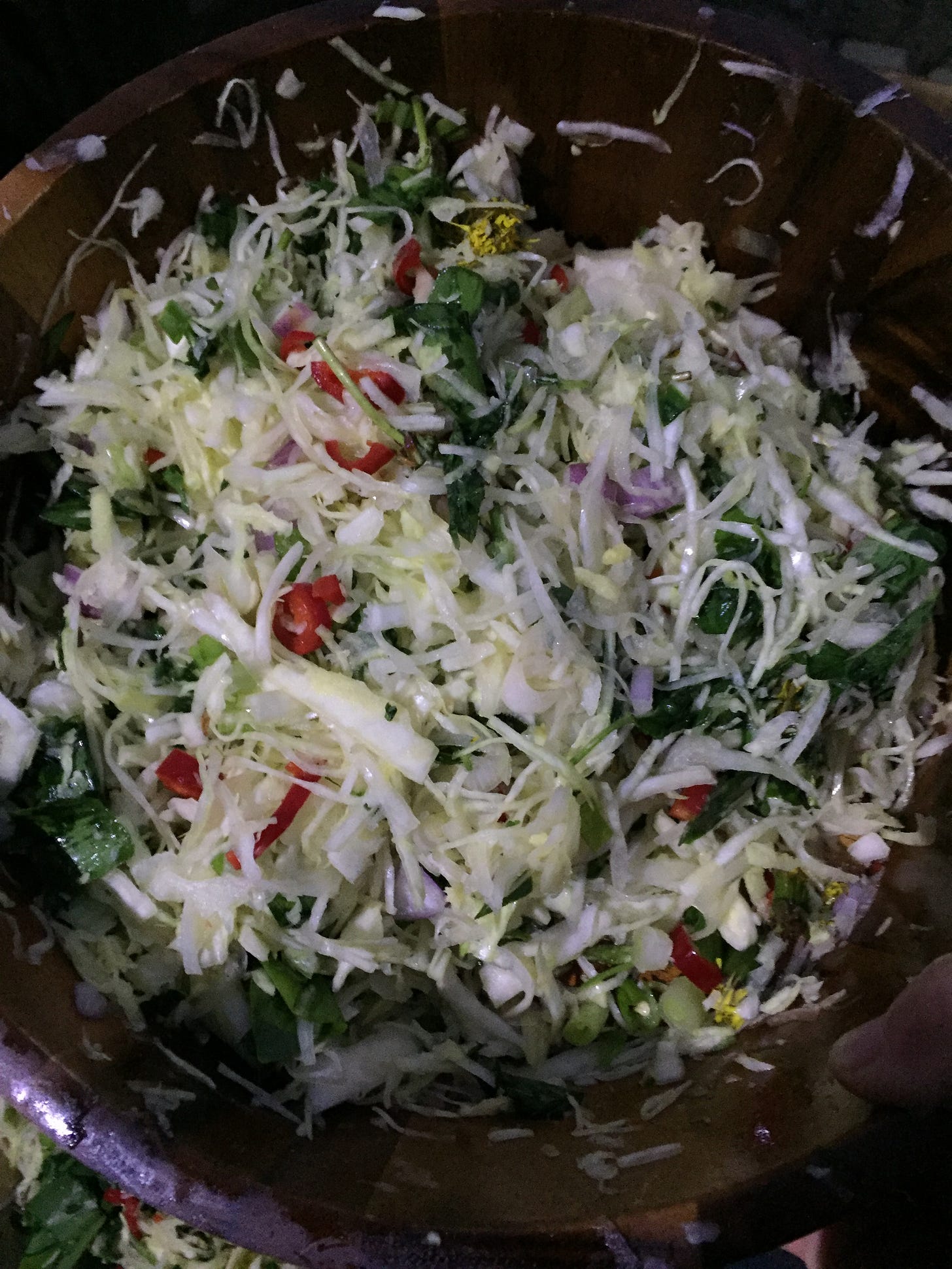

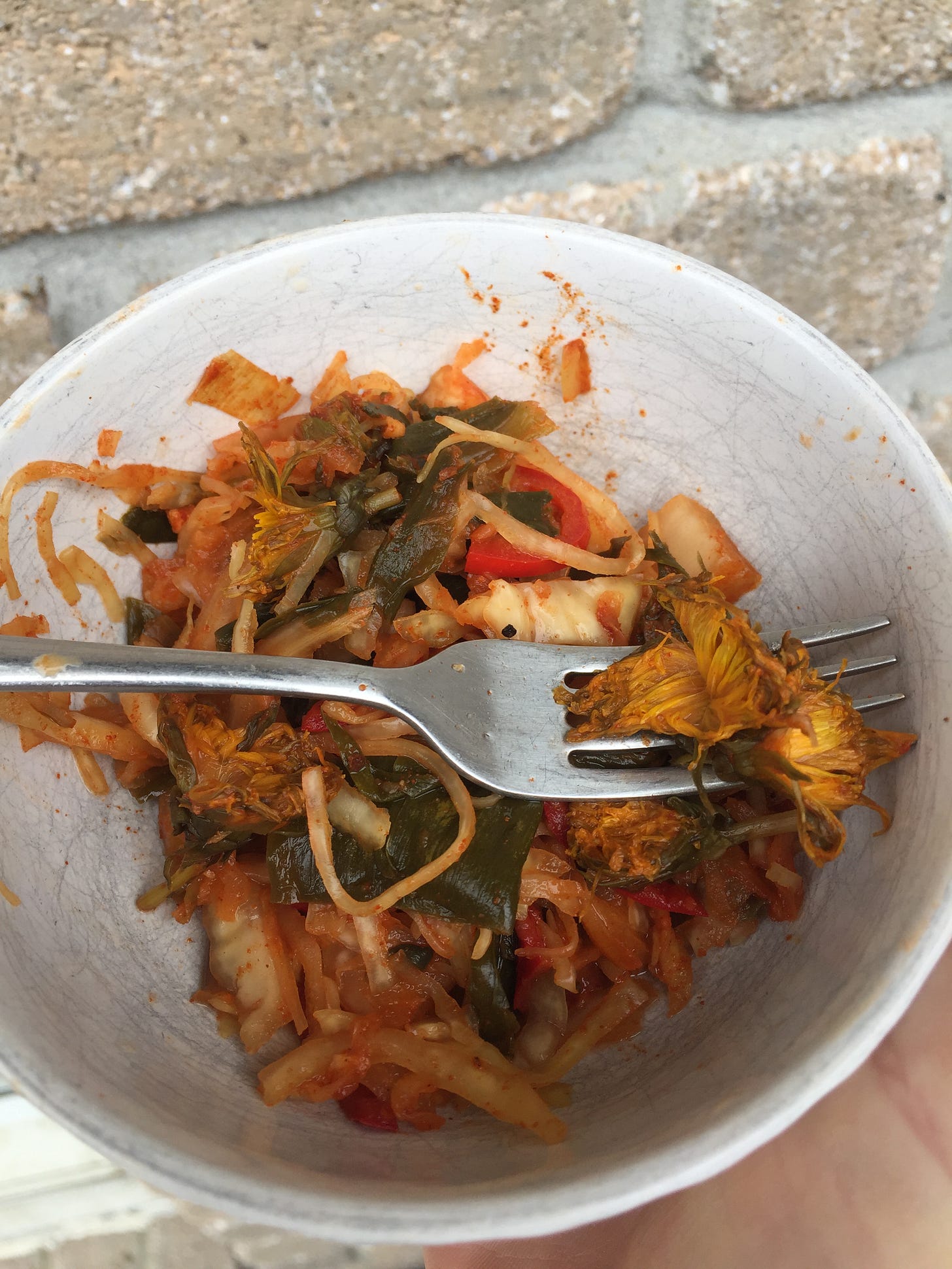
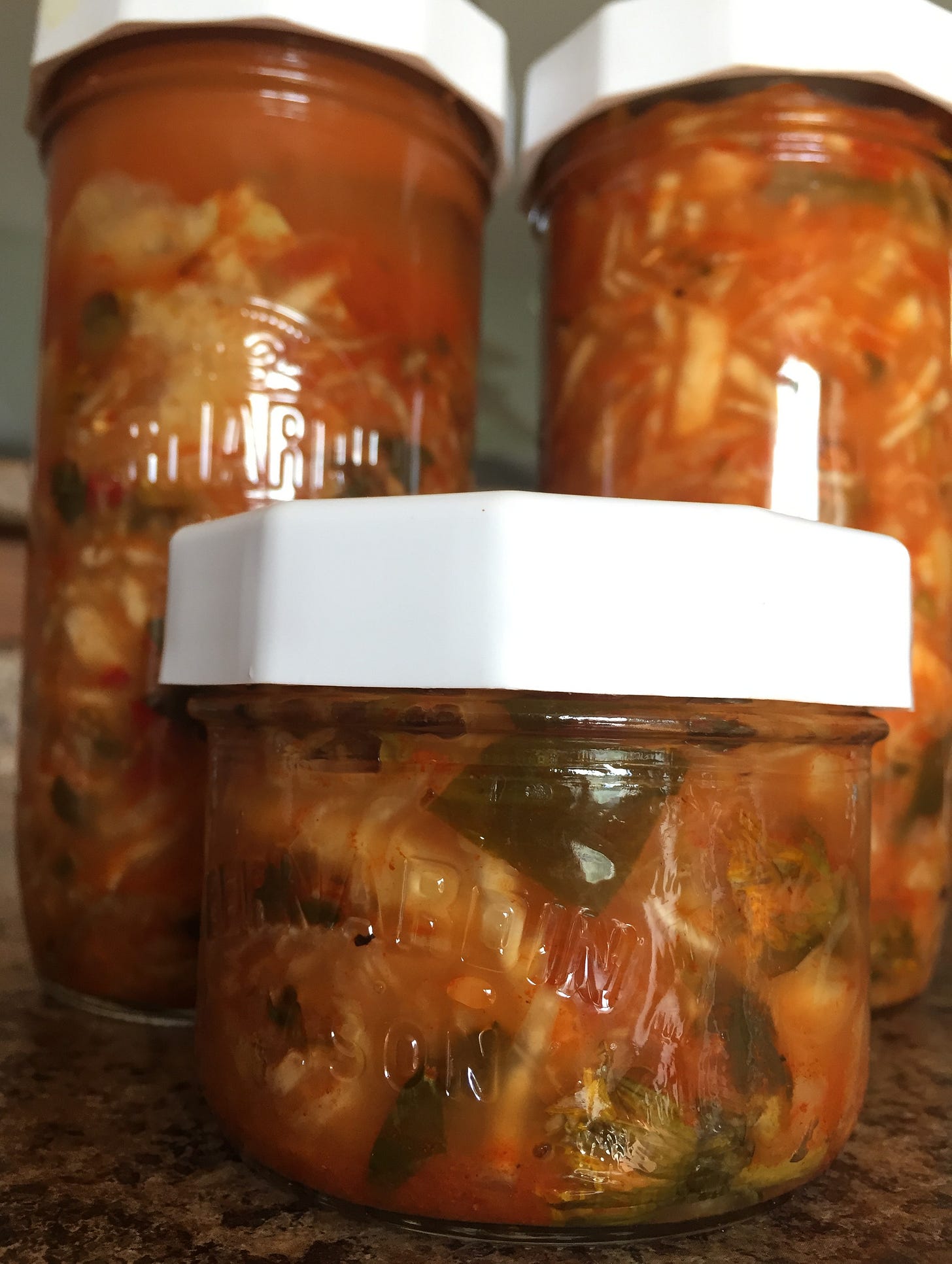
I love your Substack SOOOOO much!! And therefore, you, too. ^_^
I really want your BOOK. How can I get it? I'm in the States... Is it available here? Maybe online, like, via a book company such as Borders? or...? I'd better do this soon, b/c I was given a monetary gift, and it might not last very long...
That looks amazing. A couple of years ago I made Kimchi from some wonderful Chinese cabbage I grew and it turned out really good. I may try my hand using some of your suggestions in the future. I'm always so excited in the spring/summer when I go to the grocery store and only have to put a few poisonous items in my cart because I'm growing most of the things I need. I usually grow greens indoors in the winter, but haven't for a couple of years and have been regretting that decision. I pulled out all of my indoor growing supplies recently and will grow lettuce, spinach etc indoors this winter for sure. It's so depressing to go to the store and see a 5$ bag of something resembling spinach, bring it home and find it's certainly not fresh and heaven knows what conditions it was grown under. It would be nice to live in a place where there are the types of forests you live in. I live in a high desert with annual rainfall of 12 to 14 inches, so it's hit and miss on the types of things I can find in the wild. But, I try to do my best on my tiny little lot where I have been increasing diversity of things that grow on my lot. I've acclimated several different types of plants that typically don't grow here. About 6 years ago I started some cilantro from seeds I purchased. Took forever to get them going. Now... Oh man! I have cilantro that grows everywhere. Haha. I let several plants go to seed every year and just throw the seeds and the next year they come up. The bees love the flowers. Anyway, beautiful post as always.